2015 年 12 月英语六级真题(第 1 套)
Writing
(30 minutes)
Part I
Directions:Forthispart, you areallowed30 minutesto write ashort essay based
onthepicturebelow.Youshouldfocusontheimpactofsocialnetworking
websites on reading. You are required to write at least 150 words but
no more than 200 words.
(30 minutes)
Listening Comprehension
Part II
Section A
Directions:In this section, you will hear 8 short conversations and 2
longconversations.Attheendofeachconversation,oneormorequestions
willbeaskedaboutwhatwassaid.Boththeconversationandthequestions
willbespokenonlyonce.Aftereachquestiontherewillbeapause.During
the pause, you must read the fourchoices marked A), B), C),and D), and
decide which is the best answer.Then mark the corresponding letter on
Answer Sheet 1 with a singleline through the centre.
1. A) The restaurant offers some specials each day.
B) The restaurant is known for its food varieties.
C) The dressing makes the mixed salad very inviting.
D) The woman should mix the ingredients thoroughly.
2. A) He took over the firm from Mary.
problems.
C) He failed to foresee major
B) He is running a successful business.
D) He is opening a new consulting
firm.
3. A) Someone should be put in charge of office supplies.
B) The man can leave the discs in the office cabinet.
C) The man may find the supplies in the cabinet.
D) The printer in the office has run out of paper.
4. A) He has to use a magnifying glass to see clearly.
B) The woman can use his glasses to read.
C) He has the dictionary the woman wants.
D) The dictionary is not of much help to him.
5. A) Redecorating her office.
B) Majoring in interior design.
C) Seeking professional advice.
D) Adding some office furniture.
6. A) Problems in port management.
�
B) Improvement of port facilities.
C) Delayed shipment of goods.
D) Shortage of container ships.
7. A) Their boss.
B) A colleague.
C) Their workload.
D) A coffee machine.
8. A) Call the hotel manager for help.
B) Postpone the event until a later date.
C) Hold the banquet at a different place.
D) Get an expert to correct the error.
Questions 9 to 11 are based on the conversation you have just heard.
9. A) He shares some of the household duties.
B) He often goes back home late for dinner.
C) He cooks dinner for the family occasionally.
D) He dines out from time to time with friends.
10. A) To take him to dinner.
B) To talk about a budget plan.
C) To discuss an urgent problem.
D) To pass on an important message.
11. A) Foreign investors are losing confidence in India’s economy.
B) Many multinational enterprises are withdrawing from India.
C) There are wild fluctuations in the international money market.
D) There is a sharp increase in India’s balance of payment deficit.
Questions 12 to 15 are based on the conversation you have just heard.
12. A) They have unrealistic expectations about the other half.
B) They may not be prepared for a lifelong relationship.
C) They form a more realistic picture of life.
D) They try to adapt to their changing roles.
13. A) He is lucky to have visited many exotic places.
B) He is able to forget all the troubles in his life.
C) He is able to meet many interesting people.
D) He is lucky to be able to do what he loves.
14. A) It is stressful.
B) It is full of fun.
C) It is all glamour.
D) It is challenging.
15. A) Bothered.
B) Amazed.
C) Puzzled.
D) Excited.
�
Section B
Directions: In this section, you will hear 3 short passages. At the end of each
passage,you willhearsome questions. Boththe passageand the questions willbe
spoken only once. After you hear a question, you must choose the best answer from
thefourchoicesmarkedA),B),C) andD).ThenmarkthecorrespondingletteronAnswer
Sheet 1 with a single line through the centre.
Passage One
Questions 16 to 18 are based on the passage you have just heard.
16. A) Maintain the traditional organizational culture.
B) Learn new ways of relating and working together.
C) Follow closely the fast development of technology.
D) Learn to be respectful in a hierarchical organization.
17. A) How the team integrates with what it is supposed to serve.
B) How the team is built to keep improving its performance.
C) What type of personnel the team should be composed of.
D) What qualifications team members should be equipped with.
18. A) A team manager must set very clear and high objectives.
B) Teams must consist of members from different cultures.
C) Team members should be knowledgeable and creative.
D) A team manager should develop a certain set of skills.
Passage Two
Questions 19 to 22 are based on the passage you have just heard.
19. A) It is a platform for sharing ideas on teaching at the University of Illinois.
B) It was mainly used by scientists and technical people to exchange text.
C) It started off as a successful program but was unable to last long.
D) It is a program allowing people to share information on the Web.
20. A) He visited a number of famous computer scientists.
B) He met with an entrepreneur named Jim Clark.
C) He sold a program developed by his friends.
D) He invested in a leading computer business.
21. A) They had confidence in his new ideas.
B) They trusted his computer expertise.
C) They were very keen on new technology.
D) They believed in his business connections.
Passage Three
Questions 22 to 25 are based on the passage you have just heard.
22. A) Prestige advertising.
B) Institutional advertising.
C) Word-of-mouth advertising.
D) Distributing free trial products.
23. A) To sell a particular product.
B) To build up their reputation.
�
C) To promote a specific service.
D) To attract high-end consumers.
24. A) By using the services of large advertising agencies.
B) By hiring their own professional advertising staff.
C) By buying media space in leading newspapers.
D) By creating their own ads and commercials.
25. A) Decide on what specific means of communication to employ.
B) Conduct a large-scale survey on customer needs.
C) Specify the objectives of the campaign in detail.
D) Pre-test alternative ads or commercials in certain regions.
Section C
Directions:Inthissection,youwillhearapassagethreetimes.Whenthepassage
is readfor thefirsttime, youshouldlistencarefully forits general
idea. When tho passageis readfor thesecond time, you are requiredto
fillinthoblankswiththeexactwordsyouhavejustheard.Finally,when
tho passage is read for the third time, you should chock what you have
written.
Extinction is difficult concept to grasp. It is an 26concept. It’s not at all
like the killing of individual lifeforms that can be renewed through normal processes
of reproduction. Nor is it simply 27 numbers. Nor is it damage that can somehow be
remedied or for which some substitute can be found. Nor is it something that simply
affects our own generation. Nor is it something that could be remedied by some
supernatural power. It is rather an 28 and final act for which there is no remedy
on earth or in heaven. A species once extinct is gone forever. However many
generations 29 us incoming centuries, none of them will ever see this species that
we extinguish.
Not only are we bringing about the extinction of life
30 , we are also making
the land and the air and the sea so toxic that the very conditions of life are being
destroyed.
31 basic natural resources, not only are the nonrenewable resources
being
33 , but we are also
mining much of our renewable resources, such as the very soil itself on which
terrestrial (地球上的) life depends.
32 in a frenzy (疯狂) of processing,consuming, and
The change that is taking place on the earth and in our minds is one of the
greatest changes ever to take place in human affairs, perhaps the greatest, since
what we are talking about is not simply another historical change or cultural
34 ,
35 .
but a change of geological and biological as well as psychological order of
(40 minutes)
Reading Comprehension
Part III
Section A
Directions:In this section, there is a passage with ten blanks. You are required
toselectonewordforeachblankfromalistofchoicesgiveninaword
bank following the passage. Read the passage through carefully before
making your choices.Each choice in the bank is identified by a letter.
�
PleasemarkthecorrespondingletterforeachitemonAnswerSheet2with
asinglelinethroughthecentre.Youmaynotuseanyofthewordsinthe
bank more than once.
Questions 36 to 45 are based on the following passage.
It seems to be a law in the technology industry that leading companies eventually
lose their positions, often quickly and brutally. Mobile phone champion Nokia, one
of Europe’s biggest technology success stories, was no
36 , losing its market share
in just a few years.
In 2007, Nokia accounted for more than 40% of mobile phone sales 37But
consumers’preferences were already 38toward touch-screen smartphones. With the
introduction of Apple’s iPhone in the middle of that year, Nokia’s market share
39rapidly and revenue plunged. By the end of 2013, Nokia had sold its phone business
to Microsoft.
What sealed Nokia’s fate was a series of decisions made by Stephen Elop in his
position as CEO, which he40in October 2010. Each day that Elop spent in charge of
Nokia, the company’s market value declined by $ 23 million, making him, by the
numbers, one of the worst CEOs in history.
But Elop was not the only person at41Nokia’s board resisted change, making it
impossible for the company to adapt to rapid shifts in the industry. Most42, Jorma
Ollila, who had led Nokia’s transition from an industrial company to a technology
giant, was too fascinated by thecompany’s43success to recognize the change that
was needed to sustain its competitiveness.
The company also embarked on a44cost-cutting program, which included the
elimination of thousands of jobs. This contributed to the45of the company’s
once-spirited culture which had motivated employees to take risks and make miracles.
Good leaders left the company, taking Nokia’s sense of vision and directions with
them. Not surprisingly, much of Nokia’s most valuable design and programming talent
left as well.
A) assumed
B) bias
C) desperate
D) deterioration
E) exception
F) fault
G) incidentally
H) notably
I) previous
J) relayed
K) shifting
L) shrank
M) subtle
N) transmitting
O) worldwide
Section B
Directions:In this section, you are going to read a passage with ten statements
attachedtoit.Eachstatementcontainsinformationgiveninoneofthe
paragraphs.Identifytheparagraphfromwhichtheinformationisderived.
Youmaychooseaparagraphmorethanonce.Eachparagraphismarkedwith
a letter.Answer the questions by .marking the corresponding letter on
�
Answer Sheet 2.
First-Generation College-Goers: Unprepared and Behind
Kidswhoarethefirstintheirfamiliestobravetheworldofhighereducation
come on campus with little academic know-how and are much more likely than their
peers to drop out before graduation.
[A] When Nijay Williams entered college last fall as a first-generation student and
Jamaican immigrant,he was academically unprepared for the rigors of higher education.
Like many first-generation students, he enrolled in a medium-sized state university
many of his high school peers were also attending, received a Pell Grant, and took
out some small federal loans to cover other costs.Given the high price of room and
board and the closeness of the school to his family, he chose to live at home and
worked between 30 and 40 hours a week while taking a full class schedule.
[B] What Nijay didn’t realize about his school—Tennessee State University—was
its frighteningly low graduation rate: a mere 29 percent for its first-generation
students. At the end of his first year,Nijay lost his Pell Grant of over $5,000 after
narrowly missing the 2.0 GPA cut-off, making it impossible for him to continue paying
for school.
[C]Nijay represents a large and growing group of Americans: first-generation college
students who enter school unprepared or behind. To make matters worse, these schools
are ill-equipped to graduate these students—young adults who face specific
challenges and obstacles. They typically carry financial burdens that outweigh those
of their peers, are more likely to work while attending school, and often require
significant academic remediation (补习).
[D] Matt Rubinoff directs I’m First, a nonprofit organization launched last October
to reach out to this specific population of students. He hopes to distribute this
information and help prospective college-goers find the best post-secondary fit.
And while Rubinoff believes there are a good number of four-year schools that truly
care about these students and set aside significant resource sand programs for them,
he says that number isn’t high enough.
[E] “It’s not only the selective and elite institutions that provide those
opportunities for a small subset of this population,”Rubinoff said, adding that
a majority of first-generation undergraduates tend toward options such as online
programs, two-year colleges, and commuter state schools.“Unfortunately, there
tends to be a lack of information and support to help students think bigger and
broader. “
[F] Despite this problem, many students are still drawn to these institutions—and
two-year schools in particular. As a former high school teacher, I saw students
choose familiar, cheaper options year after year. Instead of skipping out on higher
education altogether, they chose community colleges or state schools with low bars
�
for admittance.
[G]“They underestimate themselves when selecting a university,”said Dave Jarrat,
a marketing executive for Inside Track, a for-profit organization that specializes
in coaching low-income students and supporting colleges in order to help students
thrive. “The reality of it is that a lot of low-income kids could be going to elite
universities on a full ride scholarship and don’t even realize it.”
[H] “Many students are coming from a situation where no one around them has the
experience of successfully completing higher education, so they are coming in
questioning themselves and their college worthiness,” Jarrat continued. That helps
explain why, as I’m First’s Rubinoff indicated,the schools to which these students
end up resorting can end up being some of the poorest matches for them. The University
of Tennessee in Knoxville offers one example of this dilemma. A flagship university
in the South, the school graduates just 16 percent of its first—generation students,
despite its overall graduation rate of 71 percent. Located only a few hours apart,
The University of Tennessee and Tennessee State are worth comparing. Tennessee
State’s overall graduation rate is a tiny 39 percent, but at least it has a smaller
gap between the outcomes for first-generation students and those of their peers.
[I] Still, the University of Tennessee deserves credit for being transparent. Many
large institutions keep this kind of data secret—or at least make it incredibly
difficult to find The University of North Carolina at Chapel Hill, for instance,
admits only that the graduation rate for its first-generation pupils is “much
lower” than the percentage of all students who graduate within four years (81
percent).
[J] It is actually quite difficult to find reliable statistics on the issue for many
schools.Higher education institutions are, under federal law, required to report
graduation rates, but these reports typically only include Pell recipient
numbers—not necessarily rates specific to first-generation students. Other
initiatives fail to break down the data, too. Imagine how intimidating it can be
for prospective students unfamiliar with the complexities of higher education to
navigate this kind of information and then identify which schools are the best fit.
[K] It was this lack of information that prompted the launch of I’m First in 2013,
originally as an arm of its umbrella organization, the Center For Student
Opportunity.“If we can help to direct students to more of these types of campuses
and help students to understand them to be realistic and accessible places, have
them apply to these schools at greater frequency and ultimately get in and enroll,
we are going to raise the success rate,” Rubinoff said, citing a variety of
collegesranging from large state institutions to smaller private schools.
[L] Chelsea Jones, who now directs student programming at I’m First, was a
�
first-generation college student at Howard. Like other student new to the
intimidating higher-education world, she often struggled on her path to college,
“There wasn’t really a college-bound culture at my high school,” she said. “I
wanted to go to college but I didn’t really know the process.” Jones became involved
with a college-access program through Princeton University in high school. Now, she
attributes much of her understanding of college to that: “But once I got to campus,
it was a completely different ball game that no one really prepared me for.”
[M] She was fortunate, though. Howard, a well-regarded historically black college,
had an array of resources for its first-generation students, including matching kids
with counselors, connecting first-generation students to one another, and TRIO, a
national program that supported 200 students on Howard’s campus. Still, Jones
represents a small percentage of first-generation students who are able to gain entry
into more elite universities, which are often known for robust financial aid packages
and remarkably high graduation rates for first-generation students.(Harvard,
forexample, boasts a six-year graduation rate for underrepresented minority groups
of 98 percent.)
[N]Christian Vazquez, a first-generation Yale graduate, is another exception, his
success story setting him far apart from students such as Nijay. “There is a lot
of support at Yale, to an extent, after awhile, there is too much support,” he said,
half-joking about the countless resources available at the school. Students are
placed in small groups with counselors (trained seniors on campus);they have access
to cultural and ethnic affinity(联系) groups, tutoring centers and also have asummer
orientation specifically for first-generation students (the latter being one of the
most common programs for students).
[O]“Our support structure was more like: ‘You are going to get through Yale; you
are going to do well,’” he said, hinting at mentors(导师), staff, and professors
who all provided significant support for students who lacked confidence about
“belonging” at such a top institution.
46. Many first-generation college-goers have doubts about their abilities to get
a college degree.
47. First-generation college students tend to have much heavier financial burdens
than their peers.
48. The graduation rate of first-generation students at Nijay’s university was
incredibly low.
49. Some top institutions like Yale seem to provide first-generation students with
more support than they actually need.
50. On entering college, Nijay Williams had no idea how challenging college education
was.
51. Many universities simply refuse to release their exact graduation rates for
first-generation students.
�
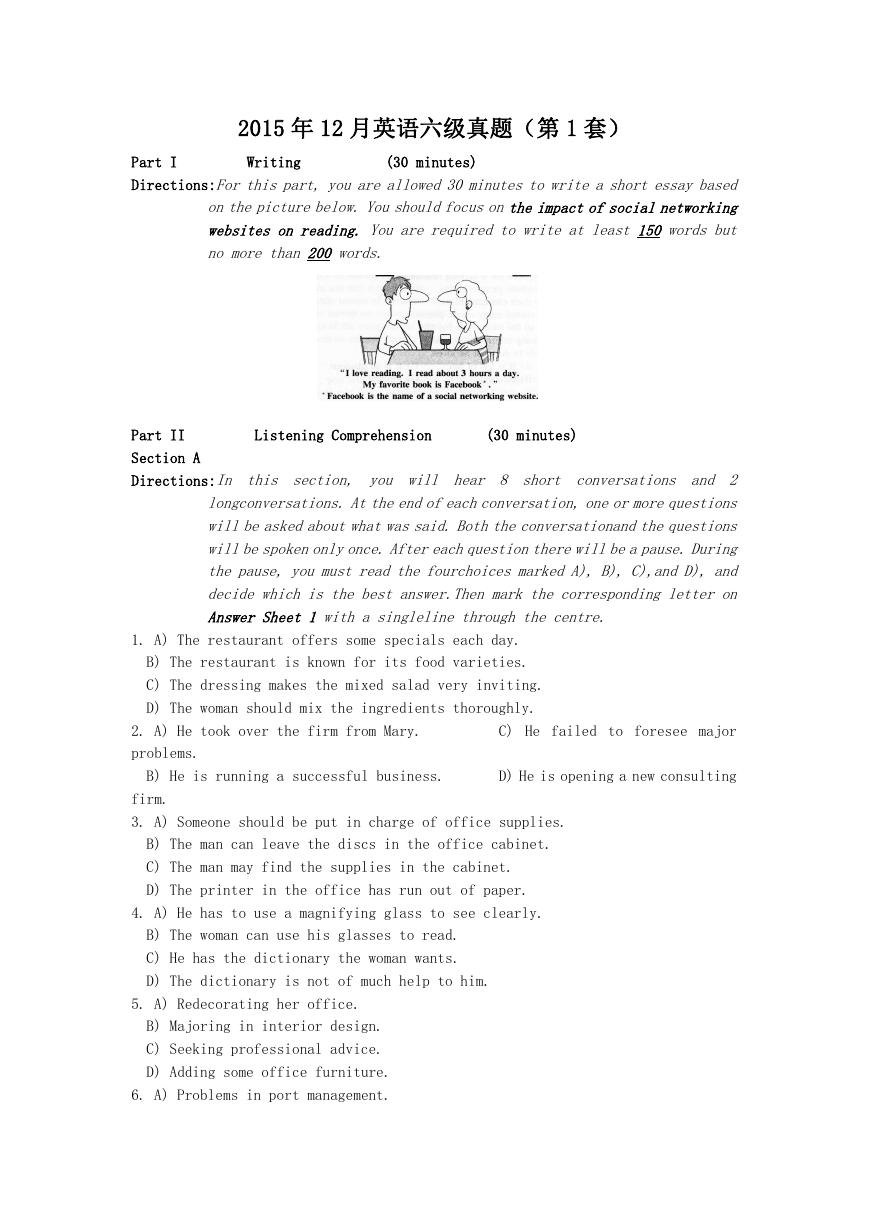
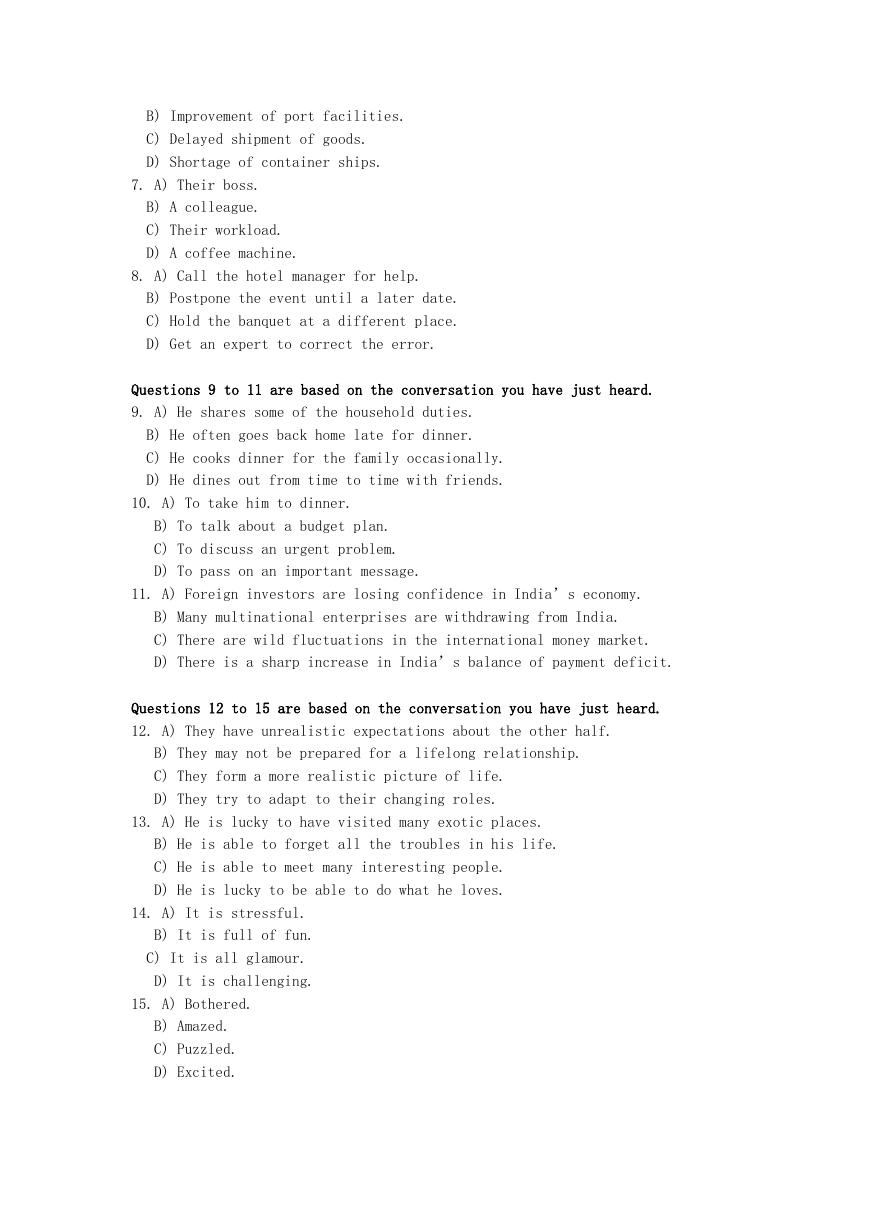
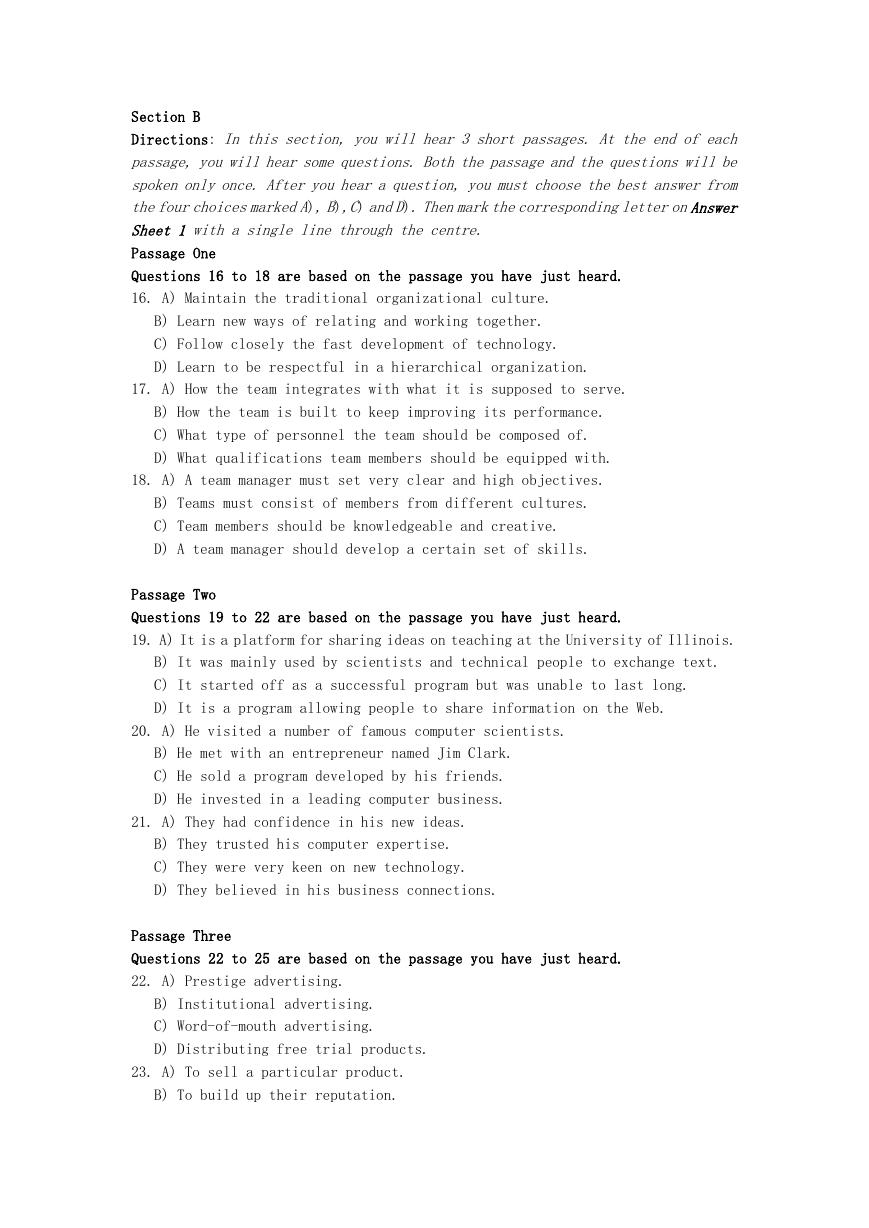
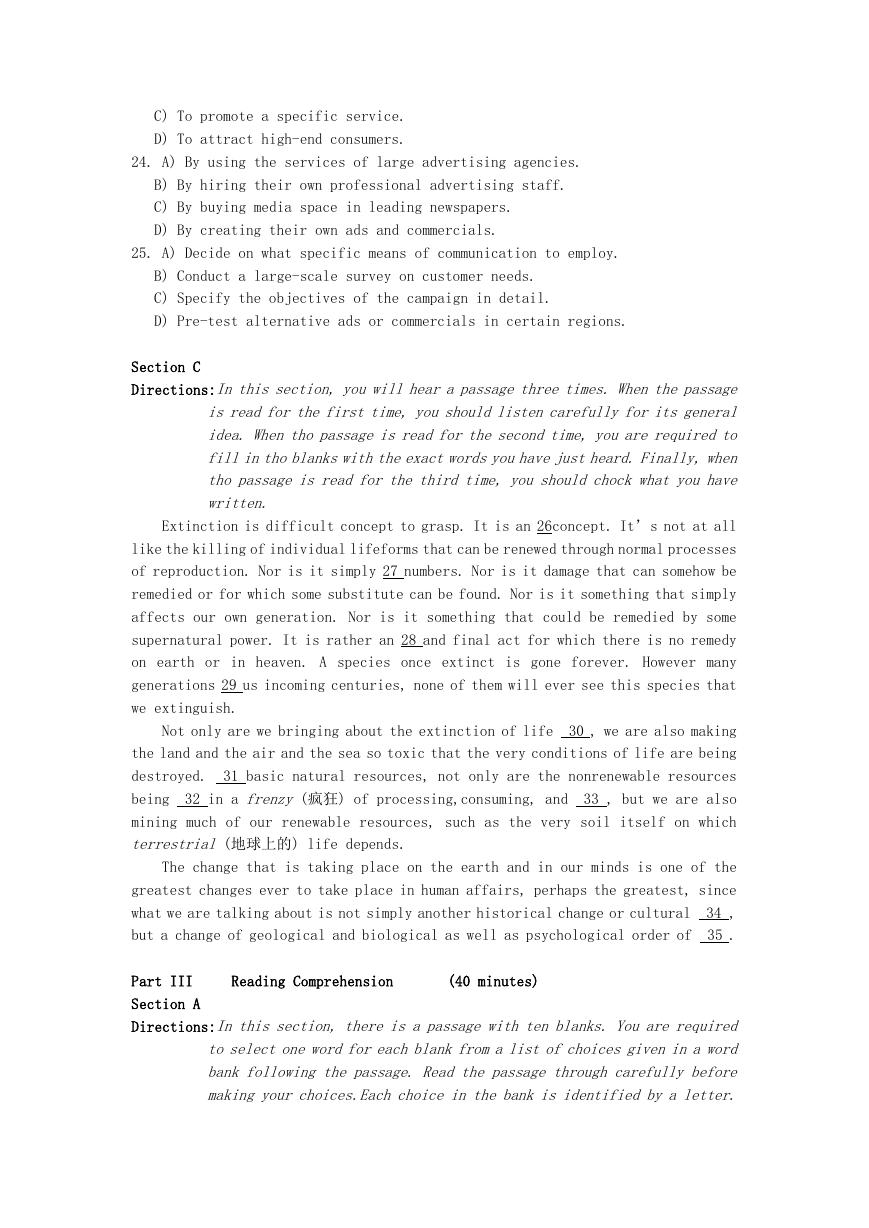
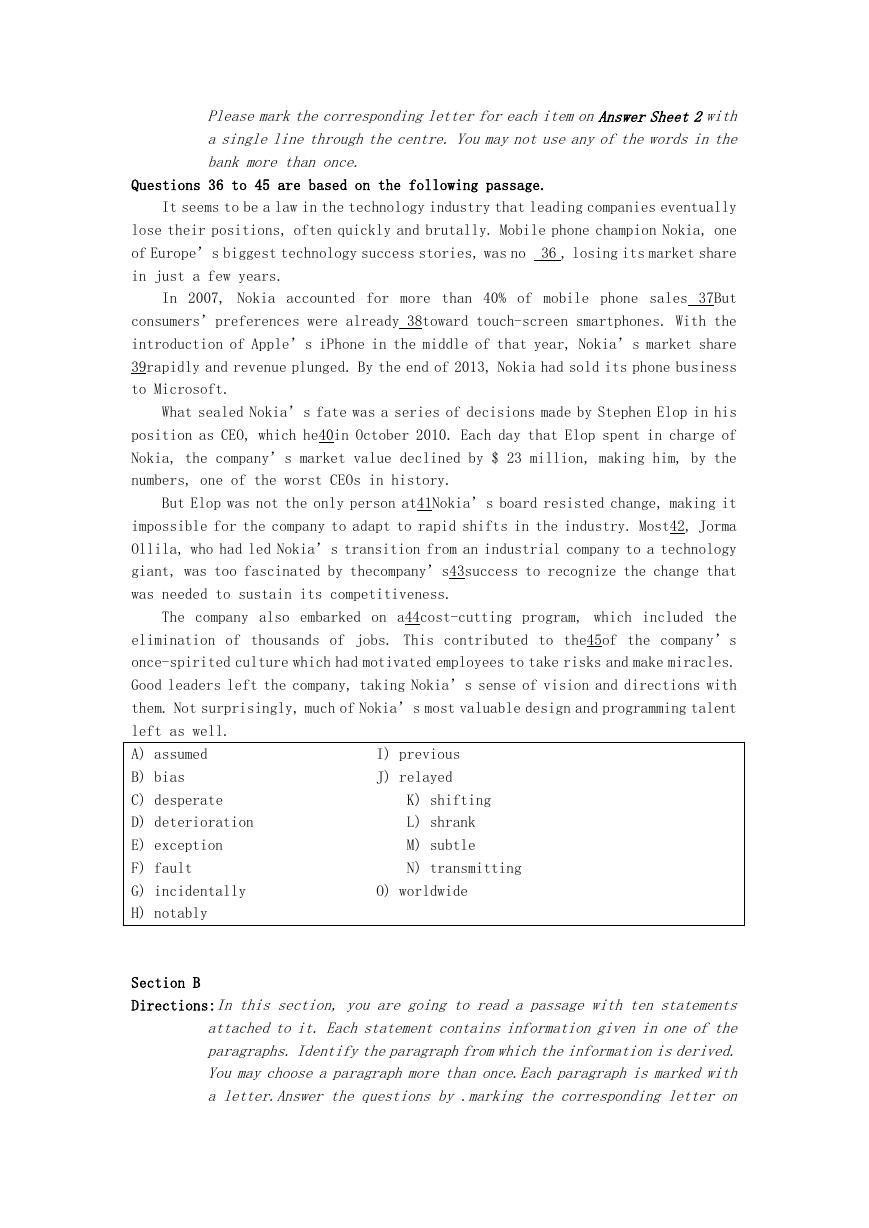
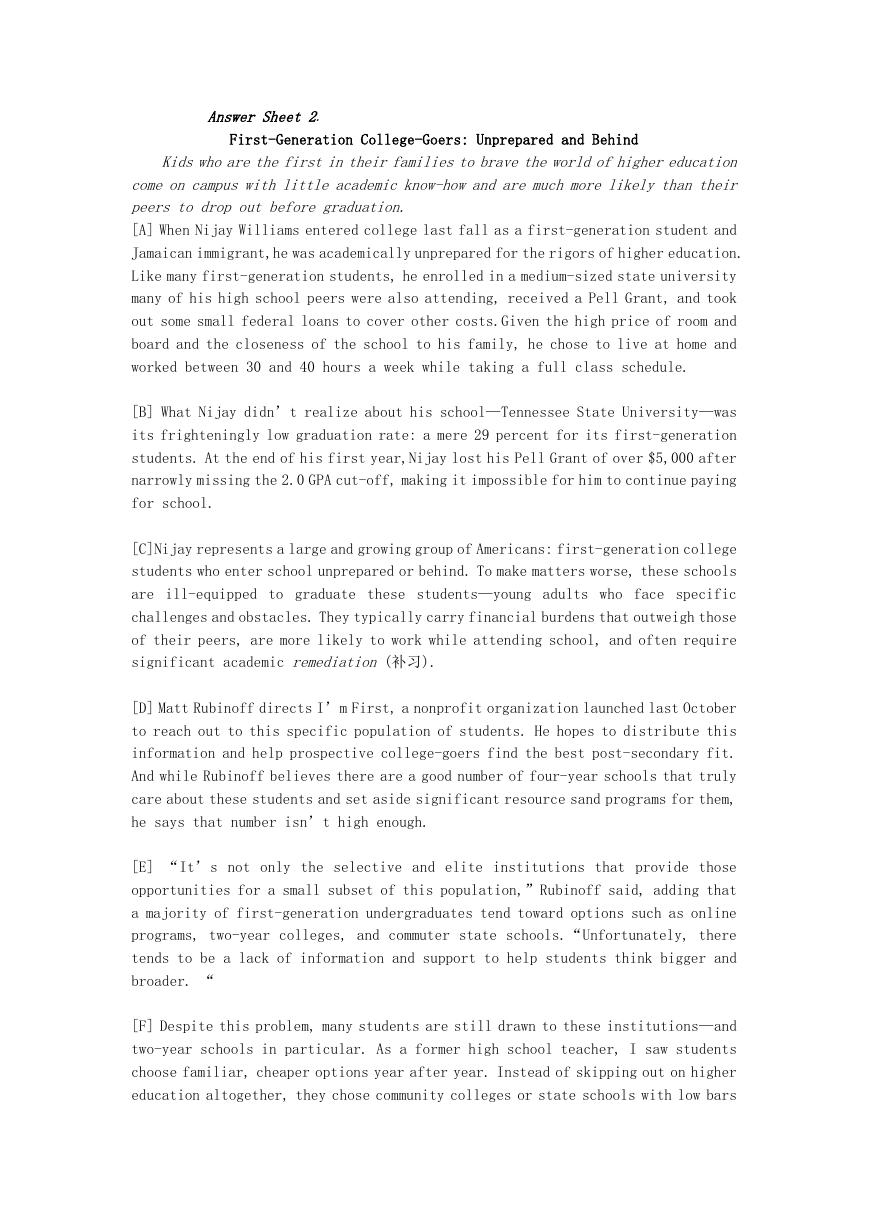
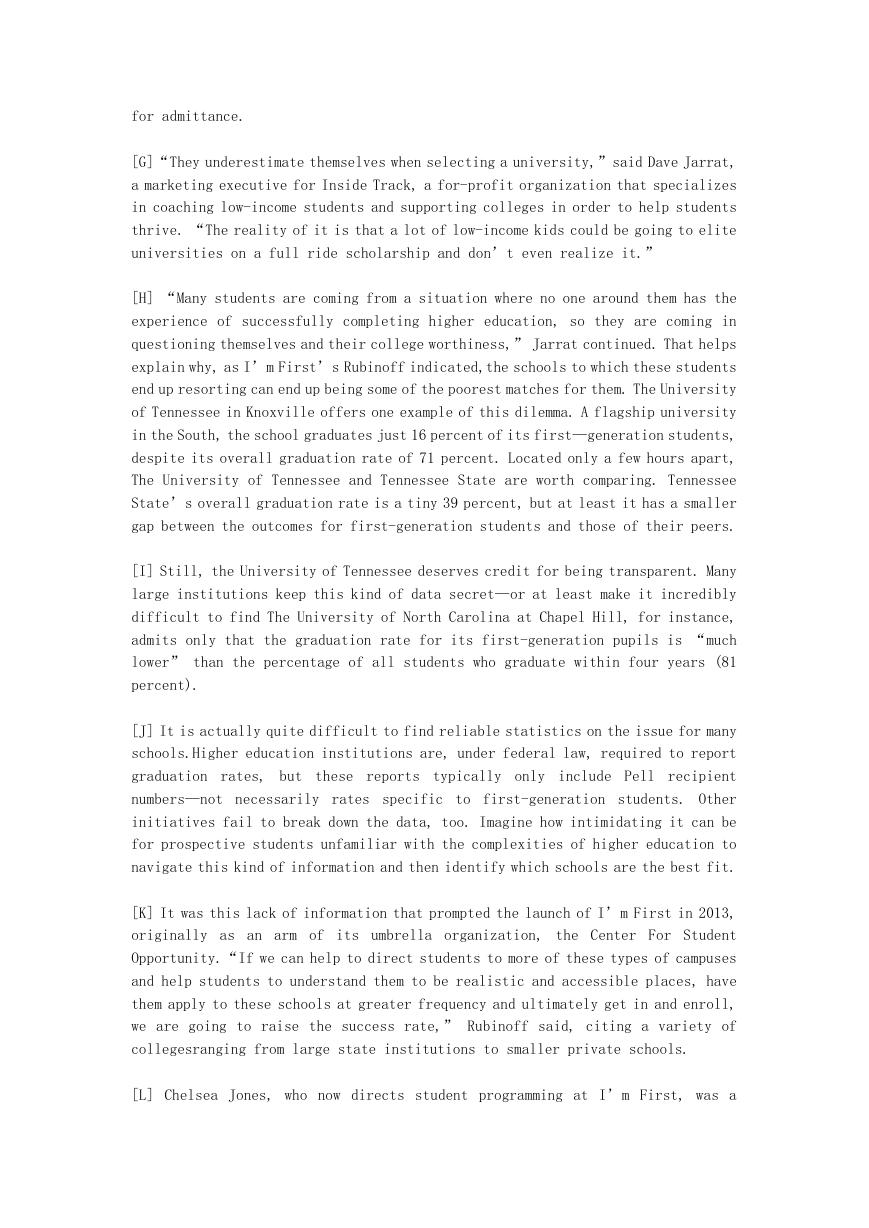
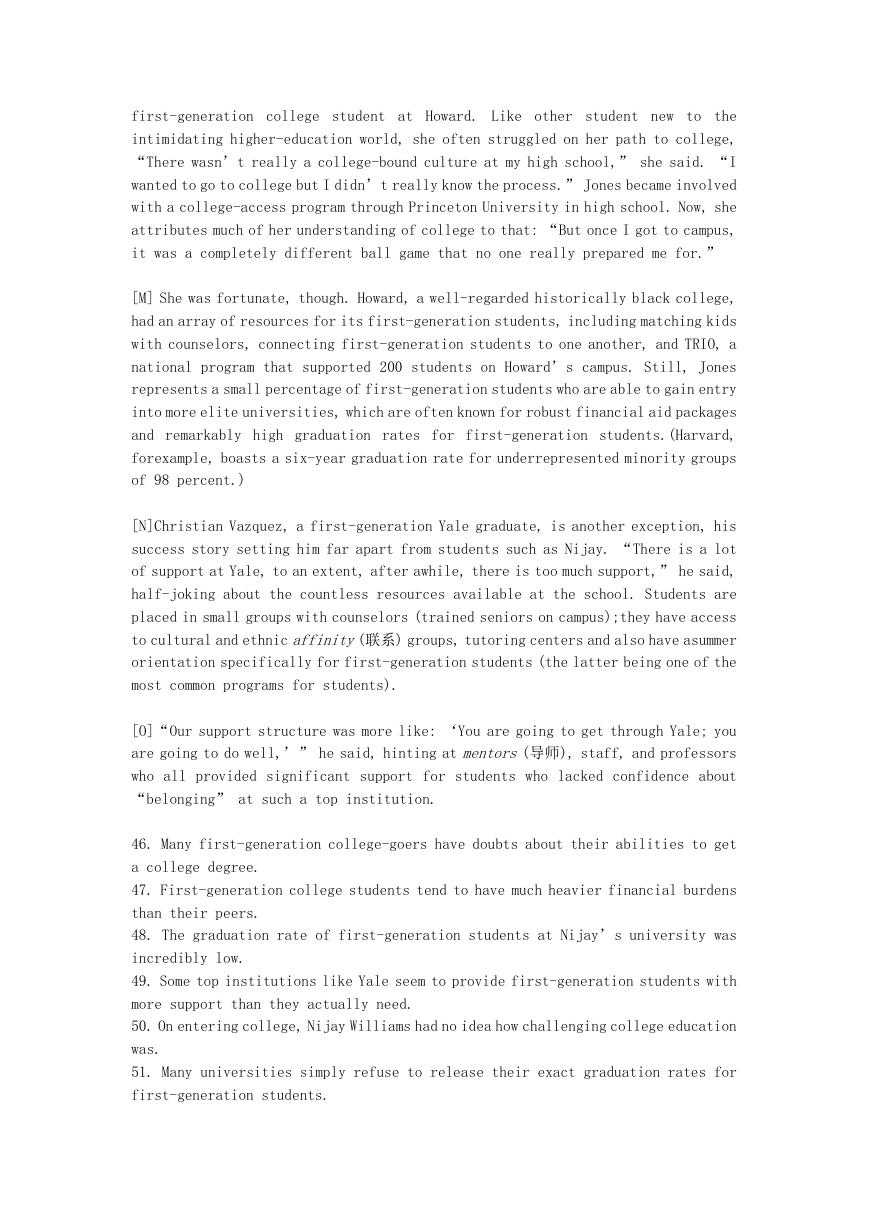








 2023年江西萍乡中考道德与法治真题及答案.doc
2023年江西萍乡中考道德与法治真题及答案.doc 2012年重庆南川中考生物真题及答案.doc
2012年重庆南川中考生物真题及答案.doc 2013年江西师范大学地理学综合及文艺理论基础考研真题.doc
2013年江西师范大学地理学综合及文艺理论基础考研真题.doc 2020年四川甘孜小升初语文真题及答案I卷.doc
2020年四川甘孜小升初语文真题及答案I卷.doc 2020年注册岩土工程师专业基础考试真题及答案.doc
2020年注册岩土工程师专业基础考试真题及答案.doc 2023-2024学年福建省厦门市九年级上学期数学月考试题及答案.doc
2023-2024学年福建省厦门市九年级上学期数学月考试题及答案.doc 2021-2022学年辽宁省沈阳市大东区九年级上学期语文期末试题及答案.doc
2021-2022学年辽宁省沈阳市大东区九年级上学期语文期末试题及答案.doc 2022-2023学年北京东城区初三第一学期物理期末试卷及答案.doc
2022-2023学年北京东城区初三第一学期物理期末试卷及答案.doc 2018上半年江西教师资格初中地理学科知识与教学能力真题及答案.doc
2018上半年江西教师资格初中地理学科知识与教学能力真题及答案.doc 2012年河北国家公务员申论考试真题及答案-省级.doc
2012年河北国家公务员申论考试真题及答案-省级.doc 2020-2021学年江苏省扬州市江都区邵樊片九年级上学期数学第一次质量检测试题及答案.doc
2020-2021学年江苏省扬州市江都区邵樊片九年级上学期数学第一次质量检测试题及答案.doc 2022下半年黑龙江教师资格证中学综合素质真题及答案.doc
2022下半年黑龙江教师资格证中学综合素质真题及答案.doc